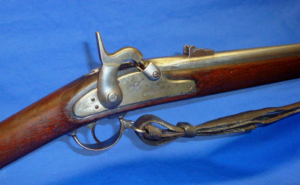The Wagon Box Fight and The Springfield Armory M1866 – Second Allin Conversion (Part 1/2)
 One of my favorite periods of study of American history and the military arms is the time between the end of the Civil War in 1865 and the Custer battle of 1876. I have been fortunate to have walked the battlefields of Northwest Wyoming in the area of the Powder River, Fort Phil Kearney and the Little Big Horn battlefield in Montana. A fascinating aspect of this period is that it was a time of great and rapid change in the transition from muzzle loading arms to repeating arms and from percussion to centerfire metallic cartridges.
One of my favorite periods of study of American history and the military arms is the time between the end of the Civil War in 1865 and the Custer battle of 1876. I have been fortunate to have walked the battlefields of Northwest Wyoming in the area of the Powder River, Fort Phil Kearney and the Little Big Horn battlefield in Montana. A fascinating aspect of this period is that it was a time of great and rapid change in the transition from muzzle loading arms to repeating arms and from percussion to centerfire metallic cartridges.
A great deal of activity centered around Fort Phil Kearny, which was established in 1866 and remained in use through 1868. The Fort was located east of the Big Horn Mountains, about 15 miles north of present day Buffalo, Wyoming. The purpose of the Fort was to protect those traveling along the Bozeman Trail during Red Cloud’s War. Red Cloud and a number of other tribal leaders wanted to stop travelers from entering their ancestral lands.
The 18th Infantry was stationed at Fort Phil Kearny. They were poorly armed with M1861 Springfield muzzle-loading rifle-muskets. In November 1866, C Company of the Second Cavalry also reported for duty. They were “poorly armed old Springfield rifles and Star (sic) carbines.” About 50 cavalrymen exchanged their Starrs for the Spencers carried by the regimental band.
On December 21, 1866 ten of Red Cloud’s warriors lured a detachment of 81 soldiers and civilians under the command of Captain William J. Fetterman into an ambush by over 1,000 Native Americans. When you see that terrain as I have it is easy to understand how that many warriors could have remained concealed until it was too late.
Fetterman’s forces carried Springfield M1861s, except for two civilian employees of the Quartermaster Department who were armed with .44 caliber rim fire Henry repeaters. Fetterman and all of his men were killed. The press called it the “Fetterman Massacre;” the Indians called it “Where a Hundred Soldiers were Killed.” Whatever its name, it was the greatest defeat and loss of life by the Army and the greatest victory by Native American forces prior to the Little Big Horn battle ten years later.
Most infantry stationed at Western posts immediately following the end of the Civil War were armed with old M1861 rifle-muskets. As a result the Indians were accustomed to soldiers having to stand to reload. A soon to be adopted weapon that allowed for reloading while prone behind cover would change warfare in the West. The Native American warriors were about to learn a costly lesson.
BY SCOTT DUFF


